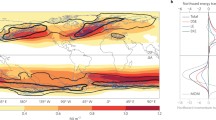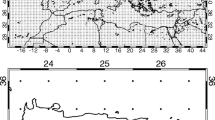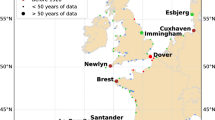Abstract
Cyclone tracks over the Great Lakes of North America shift, both East–West as well as North–South. The reasons for the shifts are various small-scale as well as large-scale processes associated with the general circulation of the atmosphere. The East–West shift has an approximate periodicity of 10 years, while the North–South shift occurs roughly with a periodicity of 20 years. The East–West shift is more important than the North–South shift. The amount of shift could be as much as a few hundred kilometers. The implication of these shifts for storm surges in the Great Lakes is considered.

(Reproduced with permission from Wikimedia Commons contributors 2014)

(Reproduced with permission from NAV Canada 2017)

(Reproduced with permission from NAV Canada 2017)

(Reproduced with permission from Birchfield and Murty 1974)

(Reproduced with permission from Birchfield and Murty 1974)

(Reproduced with permission from Murty and Polavarapu 1975)

(Reproduced with permission from Murty and Polavarapu 1975)

(Reproduced with permission from Murty and Polavarapu 1975)

(Reproduced with permission from Freeman and Murty 1972)

(Reproduced with permission from Freeman and Murty 1972)

(Reproduced with permission from Freeman and Murty 1972)

(Reproduced with permission from Murty and Freeman 1973)
Similar content being viewed by others
References
Baird WF, Freeman NG, Murty TS (1976) Reconstruction of the high water levels in Goderich Harbour during March 17–18, 1973. Report prepared by Environment Canada to the Department of Justice, Ottawa, Ontario
Birchfield GE, Murty TS (1974) A numerical model for wind-driven circulation in Lakes Michigan and Huron. Mon Weather Rev 102(2):157–165
Danard MB, Dube SK, Gonnert G, Munroe A, Murty TS, Chittibabu P, Rao AD, Sinha PC (2004) Storm surges from extra-tropical cyclones. Nat Hazards 32:177–190
Defant A (1961) Physical oceanography, vol 2. Pergamon Press Inc, New York
Donn WL, Ewing M (1956) Stokes’ edge waves in Lake Michigan. Science 124(3234):1238–1242
Fischer G (1959) Ein numerisches Verfahren zur Er-rechnung von Windstau und Gezeiten in Randmeeren. Tellus 11:60–76
Freeman NG, Murty TS (1972) A study of a storm surge on Lake Huron. In: Proceedings of the 15th conference on Great Lakes research, pp 565–582
Freeman NG, Hamblin PF, Murty TS (1974) Helmholtz resonance in harbours of the Great Lakes. In: Proceedings of the 17th conference Great Lakes Research, vol 15. The International Association for Great Lakes Research, pp 399–411
Hansen W (1956) Theorie zur Errechnung des Wasserstandes und de Stromungen in Tandmeeren nebst Anwendungen. Tellus 8:287–300
Irish SM, Platzman GW (1961) An investigation of the meteorological conditions associated with extreme wind tides on Lake Erie. U.S. Weather Bur. Tech. Rep. No. 4. Department of Meteorology, University of Chicago, May 1961
Lamb H (1945) Hydrodynamics. Dover, New York
Lawford RG (1977) A study of meteorological events which occurred on March 17th and 18th, 1973, in the vicinity of Goderich, Ontario. International Report SSU-77-6. Ontario Region of Atmospheric Environment Service
Lee JJ, Raichlen F (1972) Oscillations in harbors with connected basins. J Waterways Harbors Coastal Eng Div Proc ASCE Issue WWZ 98:311–332
Lewis PJ (1987) Severe storms over the great lakes: a catalogue summary for the period 1957 to 1985, Canadian climate center, report No. 87-13, Atmospheric environment service, Downsview, Ontario, Canada, no pagination
Miles JW (1971) Resonant response of harbours: an equivalent-circuit analysis. J Fluid Mech 46(2):241–265
Murty TS (1984) Storm surges, No. 212 canadian bulletin of fisheries and aquatic sciences, Ottawa, 897 pp
Murty TS, Freeman NG (1973) Applications of the concepts of edge waves and numerical modelling to storm surge studies on Lake Huron. In: Proceedings of the 16th conference Great Lakes research, vol 16. The International Association for Great Lakes Research, pp 533–548
Murty TS, Polavarapu RJ (1975) Reconstruction of some of the early storm surges on the Great lakes. J Great Lakes Res 1(1):116–129
NAV Canada (2017) Personal communication
N. O. A. A. (1996) Internal report of the national weather service, national oceanic and atmospheric administration, Washington, DC no report number or pagination
Platzman GW (1963) The dynamic prediction of wind tides on Lake Erie. Meteorol Mongr 4(26):44
Platzman GW (1972) Two-dimensional free oscillations in natural basins. J Phys Oceanogr 2(2):117–138
Rao DB, Murty TS (1970) Calculation of the steady-state wind-driven circulations in Lake Ontario. Arch Meteorol Geophys Bioklimatol Ser A 19:195–210
Sellinger CE, Quinn FH (1999) Proceedings of the Great Lakes paleo-levels workshop, the last 4000 years, Great Lakes environmental research laboratory, N.O.A.A, Annarbor, Michigan, USA
Shaw VK (1974) Surge study, Goderich Harbour, Ontario. Marine Engineering Design and Construction Branch, Department of Public Works, Ottawa, Ontario
Simons TJ (1973a) Development of three-dimensional numerical models of the Great Lakes. Sci. Ser. No. 12. Inland Waters Directorate, Canada Center for Inland Waters, Burlington, Ontario
Simons TJ (1973b) Comparison of observed and computed currents in Lake Ontario during Hurricane Agnes, June 1972, pp 831–844. In: Proceedings of the 16th conference on Great Lakes Research, vol 16. The International Association for Great Lakes Research
Stokes GG (1847) On the theory of oscillatory waves. Trans Cambridge Philos Soc 8:441
Ueno T (1964) Nonlinear numerical studies on tides and surges in the central part of Seto Inland Sea. Oceanogr Mag 16:53–124
Ursell F (1952) Edge waves on a sloping beach. Proc R Soc Lond Ser A 214:79–97
Wikimedia Commons contributors (2014) File:Great Lakes 1.PNG’, Wikimedia Commons, the free media repository. 6 December 2014, 23:12 UTC. https://commons.wikimedia.org/w/index.php?title=File:Great_Lakes_1.PNG&oldid=141673992 Accessed 22 July 2018
Wilson B (1972) Seiches. Adv Hydrosciences 8:1–94
Wood WL, Wood RW, Meadows GA (1995) The climatology of cyclones over the great lakes in relation to lake level change and wave climate, programs, and abstracts of the 38 conferences on Great Lakes research, p 22
Acknowledgements
Special thanks to all the authors for granting permission to reproduce their tables and figures.
Author information
Authors and Affiliations
Corresponding author
Rights and permissions
About this article
Cite this article
Mahdi, TF., Jain, G., Patel, S. et al. A review of cyclone track shifts over the Great Lakes of North America: implications for storm surges. Nat Hazards 98, 119–135 (2019). https://doi.org/10.1007/s11069-018-3429-2
Received:
Accepted:
Published:
Issue Date:
DOI: https://doi.org/10.1007/s11069-018-3429-2




